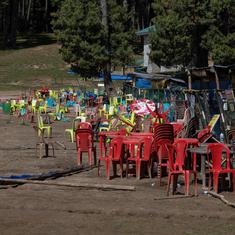Coronavirus: World Bank says South Asia’s economic performance likely to be worst in 40 years
The bank said that poor people in South Asia are more likely to become infected with Covid-19, as social distancing is difficult for them.

The World Bank said on Sunday that South Asia is likely to experience its worst economic performance in 40 years during the 2020-’21 financial year, due to the Covid-19 pandemic.
In a report titled South Asia Economic Focus, Spring 2020, the bank said that poor people in South Asia are more likely to become infected with the coronavirus, as social distancing is difficult for them. The World Bank said the poor in South Asia have less access to soap, healthcare, and are vulnerable to increases in food prices and are more likely to have lost their jobs.
“The unfolding economic crisis is unique in several ways,” the global financial organisation said. “This report estimates that regional growth will fall to a range between 1.8% and 2.8% in 2020, down from 6.3% projected six months ago. The dire forecast is based on the analysis of several adverse impacts. South Asia finds itself in a perfect storm.”
The World Bank said tourism has dried up in these countries, garment trade has collapsed, consumer and investor sentiment has deteriorated and foreign capital is being withdrawn. “On top of the deterioration of the international environment, the lockdown in most countries has frozen large parts of the domestic economy,” the bank added. It said that public banks might play an important part in lending to the most vulnerable parts of the economies of South Asian countries.
The report said that India, the most powerful economy in South Asia, is likely to grow at just 1.5% to 2.8% in the 2020-’21 financial year, as against 4.8% to 5% in 2019-’20. Pakistan’s economy is likely to shrink by 1.3% to 2.2%, while Afghanistan’s will shrink by 3.8% to 5.9%.
On April 8, United States-based multinational investment bank Goldman Sachs predicted that India’s Gross Domestic Product will grow by just 1.6% in 2020-’21, the slowest in several decades, instead of the 5.8% it had projected before the coronavirus pandemic began. Late last month, credit rating agency Moody’s slashed India’s growth forecast from 5.3% to 2.5%.
Migrant labour crisis
Another World Bank report released on Sunday warned that migrant labourers in South Asian countries returning home from their place of work could be the biggest vectors of the virus, PTI reported. The World Bank said South Asia is one of the highest population density areas in the world, and therefore preventing domestic transmission of the contagion is extremely difficult.
“This makes contagion easier, especially among the most vulnerable people: slum dwellers and migrant workers,” it said. “The flow of migrant workers could easily become vectors carrying the coronavirus back to other states and villages.”
India has enforced a 21-day nationwide lockdown starting March 25. However, as the announcement was made just hours before the curfew began, tens of thousands of migrant labourers began a journey on foot to their villages. But the Centre intervened to ask state governments to seal their borders, fearing the exodus would trigger a large outbreak of coronavirus in rural areas.
“Preliminary findings indicate that in India, high-outmigration areas are more likely to have Covid-19 cases,” the report said. “Use available big data and digital data to analyse patterns of reverse migration and movement around the country, to more precisely identify potential hotspots.”
India has so far reported 8,356 cases of the coronavirus, including 273 deaths, 715 recoveries and one migration, according to the Ministry of Health and Family Welfare. However, most of the cases have been reported from urban areas, especially major cities like Mumbai and Delhi.
The World Bank report said that a minor advantage for South Asia is that it has a low percentage of people above the age of 65, which could limit the death rates, as the virus kills the elderly disproportionately.
The pandemic has infected over 1.77 million people worldwide and killed over 1,08,000, according to an estimate by Johns Hopkins University.









